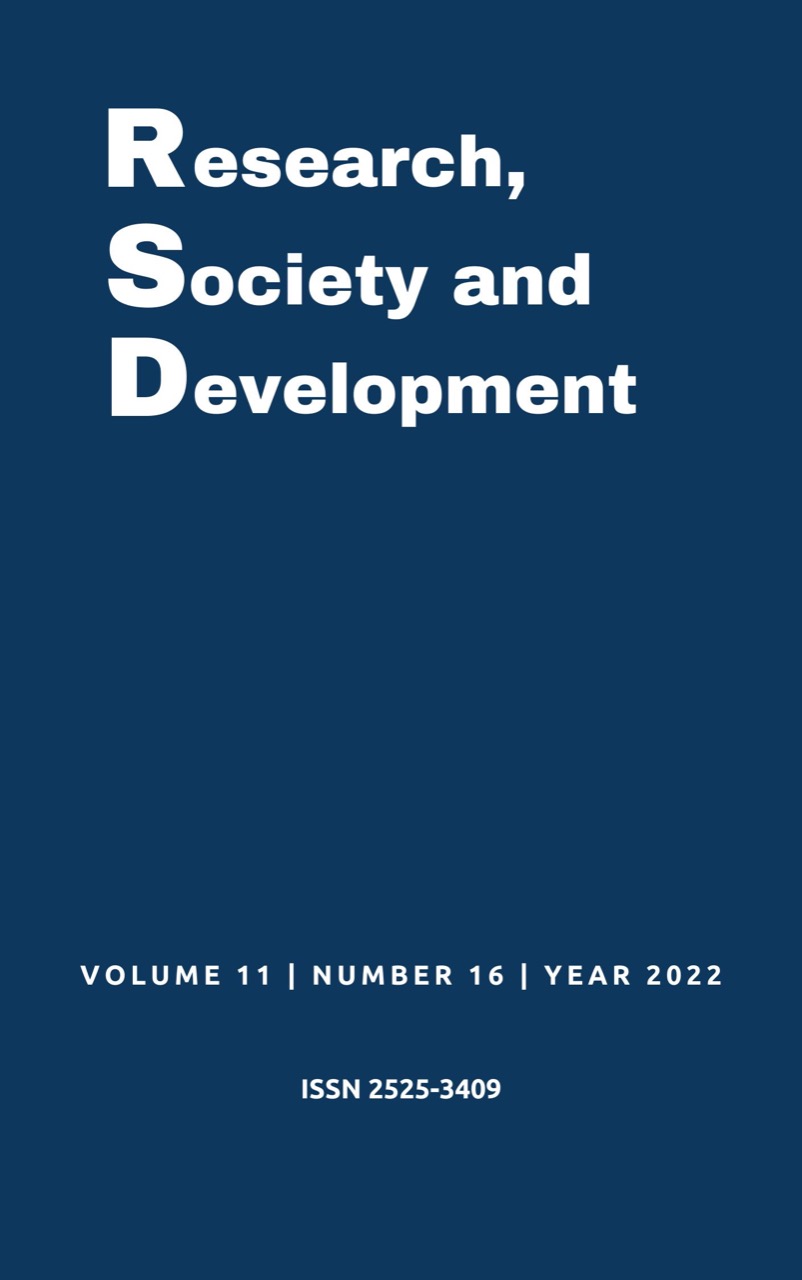Chitosan as a Strategy in the Treatment of Effluent
DOI:
https://doi.org/10.33448/rsd-v11i16.36819Keywords:
Chitosan, Textile effluent, Stabilization lagoon.Abstract
The treatment of effluents requires new methodologies for the treatment of the tailings. One option is the use of natural coagulants. Chitosan has amino groups in the polymeric chains that allow it to act as a cationic polyelectrolyte and present a high density of charges, which are easily adsorbed on negatively charged surfaces, which is the case for most colloidal impurities present in water. Thus, this work used chitosan in the coagulation/flocculation process to remove color, turbidity and suspension of solids, as a strategy in the treatment of effluents. For that, samples of effluents from the textile industry in the of State of Rio Grande do Norte and samples of effluents from stabilization Lagoons in the municipalities of Touros and Santa Cruz were used in the coagulation/flocculation tests using jar-test. The results proved to be efficient for the removal of color, turbidity and suspension of solids from the samples. The best dosages were 22.5 mg/L and 37.5 mg/L for textile industry effluents, 52.5 mg/L and 60 mg/L for Santa Cruz lagoon effluent; 30 mg/L and 37.5 mg/L for effluent from Touros lagoon. It was observed in this work that chitosan presented in an optimal proportion, that is, the addition of more chitosan did not provide greater removal and that it can be used as a coagulant/flocculant in the treatment of effluents from both the textile industry and domestic effluents, replacing the synthetic coagulants or being used together with them.
References
Dicionário Informal (2012). Efluente em Dicionário Informal. https://www.dicionarioinformal.com.br/significado/efluente/6863/
Jordão, E. P., & Pêssoa, C. A. (1995). Tratamento de Esgoto Doméstico. (3a ed.) Ed. ABES.
Pinheiro, H. M., Touraud, E., & Thomas, O. (2004). Aminas aromáticas da redução de corante azo: revisão de status com ênfase na detecção espectrofotométrica UV direta em efluentes da indústria têxtil. Corantes pigmentos. 61, 121–39.
Zamora, P., Kunz, A. P., Moraes, S. G., & Duran, N. (2002). Novas tendências no tratamento de efluentes têxteis. Química. Nova 25, 78 – 82.
Moraes, L. C. K., Bergamasco, R., Tavares, C. R. G., & Ribeiro, R. M. (2005). Utilização do polímero natural quitosana no processo de coagulação/floculação/ultrafiltração para a produção de água potável. 23º Congresso Brasileiro de Engenharia Sanitária e Ambiental.
Kawamura, S. (1991). Effectiveness of natural polyelectrolytes in water treatment. J. AWWA, 10, 88-91.
Melo, D. S. (2022). Employment of chitosan in the removal of pollutants in fish processing affluents. Arq. Bras. Med. Vet. Zootec, 74(5), 800-806.
Costa, D. A., et. al. (2017). Avaliação da remoção de cromo (III) por materiais compósitos porosos adsorventes de PE-g-MA, fibra de coco e quitosana, usando planejamento experimental. Engenharia Sanitária Ambiental, 22(6), 1203-1213.
Vaz, L. G. L., et. al. (2010). Avaliação da eficiência de diferentes agentes coagulantes na remoção de cor e turbidez em efluente de galvanoplastia. Eclética Química, 35(4), 45-54.
Rego, O. C. (2022). Uso de nanopartículas de quitosana como reagents na flotação de calcopirita em tubo de Hallimont. Tese de doutorado, Porto Alegre, 56.
Giannetti-Morandim, A. A., et. al. (2017). Tratamento de efluentes de curtume a partir da adsorção em quitosana submetida a tratamento com líquido iônico. The jornal of Engineering and exact Sciences – JCEC, 3(2), 267-280.
Lucena, G. L. (2013). Remoção de corantes têxteis a partir de soluções aquosas por quitosana modificada com tioacetamida. Revista Ambiente e Água – Na interdisciplinar jornal of Applied Science, 8(1), 144-154.
Barcellos, I. O. (2008). Blenda de náilon-6,6/quitosana como adsorvente de corantes ácidos para reutilização das soluções de corantes tratados em tingimentos de poliamida. Polímeros: Ciência e Tecnologia, 18(3), 215-221.
Janegtiz, B. C. (2007). Desenvolvimento de um método empregando quitosana para remoção de íons metálicos de águas residuárias. Química Nova, 30(4), 879-884.
Laus, R., et. al. (2006). Microesferas de quitosana reticuladas com tripolifosfato utilizados para remoção de acidez, ferro (III), e manganês (II) de água contaminada pela mineração de carvão. Química Nova, 29(1), 34-39.
Silva, F. J. A., Silveira Neto, J. W., Mota, F. S. B., & Santos, G. P. (2001). Descolorização de efluente de indústria têxtil utilizando coagulante natural (Moringa Oleiffera e Quitosana). 21º Congresso Brasileiro de Engenharia Sanitária e Ambiental.
Spinelli, V. A., Sens, M. L., & Fávere, V. T. (2001). Quitosana, polieletrólito natural para o tratamento de água potável. 21º Congresso Brasileiro de Engenharia Sanitária e Ambiental.
Valentini, A. et. al. (2000). Processo alternativo para remoção de cobre (II) e níquel (II) de soluções aquosas utilizando cápsulas de quitosana – álcool-polivinilico. Química Nova, 23(1), 12-15.
Tsaih, M. L., & Chen, R. H. (1999). Effects of ionic strength and pH on the diffusion coefficients and conformation of chitosan molecule in solution. Journal of Applied Polymer Science, 73, 2041 – 2050.
Tonhi, E., & Plepis, A. M. G. (2002). Obtenção e caracterização de blendas colágeno-quitosana. Química Nova, 25(6), 943-948.
Downloads
Published
Issue
Section
License
Copyright (c) 2022 Marina de Oliveira Cardoso Macêdo; Haroldo Reis Alves de Macêdo; André Luís Calado Araújo

This work is licensed under a Creative Commons Attribution 4.0 International License.
Authors who publish with this journal agree to the following terms:
1) Authors retain copyright and grant the journal right of first publication with the work simultaneously licensed under a Creative Commons Attribution License that allows others to share the work with an acknowledgement of the work's authorship and initial publication in this journal.
2) Authors are able to enter into separate, additional contractual arrangements for the non-exclusive distribution of the journal's published version of the work (e.g., post it to an institutional repository or publish it in a book), with an acknowledgement of its initial publication in this journal.
3) Authors are permitted and encouraged to post their work online (e.g., in institutional repositories or on their website) prior to and during the submission process, as it can lead to productive exchanges, as well as earlier and greater citation of published work.


